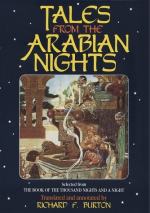[FN#120] I have already noted that “Hilal” is the crescent (waxing or waning) for the first and last two or three nights: during the rest of the lunar month the lesser light is called “Kamar.”
[FN#121] The sense is that of Coleridge.—
To
be beloved is all I need;
And
whom I love I love indeed.
[FN#122] There is something wrong in the text. I cannot help again drawing the reader’s attention to the skilful portraiture of the model Moslem Minister, the unfortunate Ja’afar. He is never described in the third person; but the simple dialogue always sets him off as a wise, conciliatory, benevolent, loveable and man-loving character, whose constant object is to temper the harshness and headstrong errors of a despotic master as the Caliph is represented to be by way of showing his kingliness. See vol. i., 102. [The Ms. is certainly wrong here, but perhaps it can be righted a little. It has: “Kad yakun Z R H ahad fi Mal jazil wa harab al-Maz’un,” etc., where Sir Richard reads “zarra-hu"=he harmed, and Mazghun=the hated one, i.e. enemy. I have a strong suspicion that in the original from which our scribe copied, the two words were “zamin” and “al-Mazmun.” Zamin in the Arabic character would be {Arabic characters} The loop for the “m,” if made small, is easily overlooked; the curve of the “n,” if badly traced, can as easily be mistaken for “r” and a big dot inside the “n” might appear like a blotted “h”. Mazmun would become “Maz’un” by simply turning the “m” loop upwards instead of downwards, an error the converse of which is so frequently committed in printed texts. Curiously enough the same error occurs p. 192 of the Ms., where we shall find “na’ ’al” with two ’Ayns instead of “na’mal” with ’Ayn and Mim. If this conjecture is correct the sense would be: Haply he may have stood security for someone for much money, and the person for whom security was given, took to flight, etc. For “zamin” with the acc. see Ibn Jubair ed. by Wright, 77, 2. I may say on this occasion, that my impression of the Montague Ms. is, that it is a blundering copy of a valuable though perhaps indistinctly written original.—St.]
[FN#123] In text “’Aurat"=nakedness: see vol. vi. 30.
[FN#124] In Arab. “’Urrah”: see Fatimah the Dung in vol. x. 1.
[FN#125] [In the Ms. “bi-Wujuh al Fanijat al-Milah.” The translator conjectures “al-fatihat,” which he refers to “Wujuh.” I read it “al-Ghanijat,” in apposition with al-Milah, and render: the faces of the coquettish, the fair. See index under “Ghunj.”—St.]
[FN#126] In text “Ballat,” the name still given to the limestone slabs cut in the Torah quarries South of Cairo. The word is classical, we find in Ibn Khaldun (vol. i. p. 21, Fr. Trans.) a chief surnomme el-Balt (le pave), a cause de sa fermete et de sa force de caractere.
[FN#127] In text “Usburu"=be ye patient, the cry addressed to passengers by the Grandee’s body-guard.




